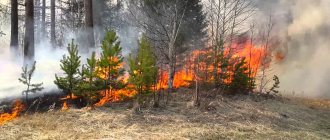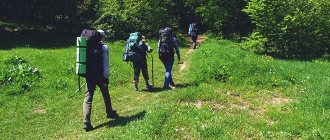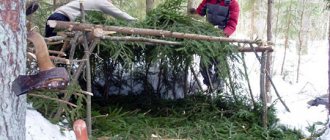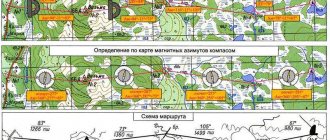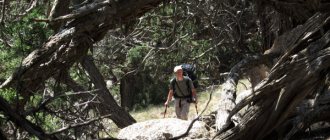Natural environmental, material and technical, stress and environmental factors of survival and risk.
Every person who goes on a long journey by any type of transport or on foot must subconsciously be ready to act in a sudden emergency, catastrophic and even extreme situation. Maximum composure and restraint, the ability to instantly pull yourself together and focus on the main thing is what will help you save your life, and not only your own, and get out of the situation with honor. from bad weather and predatory animals and subsequent access to housing. In this case, the smallest thing distracts from bad thoughts, hardships and deprivations of the current situation.
Feeling of fear as a survival and risk factor.
Psychologists believe that survival based only on the biological laws of self-preservation is short-lived. This condition is characterized by rapidly developing mental disorders, hysterical and panic states. But, however, the first thing that comes to a person in a moment of mortal danger is fear. Fear is a natural human feeling. It is caused by both real and apparent danger, the expectation of suffering and death. Fear is one of the forms of a person’s emotional reaction to an extreme situation.
Fear sharply intensifies from loneliness, when a person who finds himself in a difficult, unusual situation for him is left absolutely alone and the feeling of fear comes from the unknown, the incomprehensibility of his position, weakness of spirit, and the expectation of an attack by wild animals. There are no people in the world who do not have a sense of fear (it is not normal when it is absent), since fear is a kind of warning system about danger, and therefore about the need to take measures to preserve life.
On the other hand, fear can also cause a complete loss of strength, mental balance and the ability to resist the current situation. Controlling fear is an opportunity to understand the situation and the danger that lurks and find a way out of a seemingly hopeless situation. Thus, the main thing in a person who finds himself in an extreme situation is his will, desire for life, composure and the ability to overcome the instinct of self-preservation, which sometimes leads to making spontaneous, rash decisions.
If a person has overcome fear, then fear becomes an assistant, a kind of catalyst for energy. The brain begins to think better, the muscles tense, and vision becomes sharper. But if you succumb to fear, it will subjugate all your thoughts and actions, turning into horror of what has already happened and the future.
This will destroy in a person all the possibilities of controlling his actions and will sharply reduce the possibility of survival, even in the presence of fire, water and food. Therefore, actions taken for the first time in the minutes of a catastrophic situation are decisive. The speed with which a person comes to his senses, and the subsequent efficiency and correctness of actions, determines the outcome of survival in the most unfavorable conditions.
How to survive in the wild without becoming a victim
Long self-isolation in the wild inevitably involves obtaining food through hunting. This task is not as simple as it seems: the option of taking a gun, putting on a bandoleer, a knife and putting matches in your pocket - disappears immediately. That is, you can try, but it’s unlikely to last long. We asked an expert whether a person who decides to take refuge in the forest is able to feed himself by hunting and what is needed for this.
Doomed to Hunger
Theoretic scientists and even practical hunters claim that hunting is not the most reliable way to provide yourself with food. Only a small team moving over a fairly vast area can survive in this way. “People realized very early from experience that the food base of hunters cannot withstand high population concentrations,” he wrote in his book “Nature and Power. World environmental history” by German historian Joachim Radkau.
Weapons of the apocalypse: which weapon is better to face a crisis with?
In different parts of the world, the history of the human hunter began with an environmental fiasco - the extermination of many species of large animals. According to the scientist, even in the Stone Age, when there were many more animals on our planet than people, hunters and gatherers “in some form practiced limiting their numbers.” What can we say about today, when the density of animals and birds is low?
“Hunting urgently requires some kind of supporting economy: cattle breeding, farming, fishing,” says Mikhail Krechmar, editor-in-chief of the Russian Hunting Journal. At the same time, the supporting economy very quickly ceases to be supporting and becomes the main one. And hunting transforms into support, and then turns into a hobby. According to our interlocutor, now on the territory of Russia there is only one small people who can be called hunting - these are the Evenks, in the old way the Tungus. But even among them, hunting is associated with another type of activity - small-herd reindeer husbandry. Among the Evenks, reindeer husbandry is subordinated to hunting, and all other indigenous small peoples of the North “were originally reindeer herders, fishermen or hunters of sea animals.” This is already a reason to think about it.
How much meat do you need?
To understand whether it will be possible to survive in the forest by hunting, let’s try to establish standards for meat consumption and calculate how much prey a survivalist will need in long-term isolation. According to the reference data cited by Mr. Kretschmar, an adult man needs 180-220 grams of meat per day, a woman 130-150 grams. It looks modest. For the sake of objectivity, let’s take the general military ration, norm No. 1 (based on the Decree of the Government of the Russian Federation of July 10, 1992 and March 31, 1998 No. 377). Here the table is more generous: 250 grams of meat plus 120 grams of fish, not counting eggs, cereals, bread, potatoes, vegetables, and dairy products. By the way, all these cereals, milk, vegetables will also need to be replaced with something.
Which weapon is best for survival in long-term self-isolation?
But let's focus on meat. We get from 180 to 370 grams (meat and fish) per day, or from 65 to 133 kg of meat per man per year. Let's look at the example of game. An average-sized elk weighs 350-450 kg, but the share of “marketable meat products” in it is approximately 40-50% of the live weight. This means that from one elk you can get 160-200 kg of meat. Well, if we focus on the minimum consumption level (65 kg of meat per year), then one hunted animal can feed two or even three self-isolating people. But if you look at army standards - and survival in the taiga is no less energy-intensive than military service - then an elk will feed only one man (well, there will be a little left). But in the group there may be women, children, old people who are not able to hunt...
Why is elk preferable, and not something smaller, like a hare or a bird, which is our main game? Of course, in reality, any living animal that you can eat will do, but let’s try to calculate: a goose weighs about 2 kg, and it contains 40% meat, which means that to replace one elk you need to get 150-200 geese, and to get the minimum amount of “meat” allowance" will require at least 100 geese per year. Really more. How many hunters hunt 200 geese (not on the Internet, but in the forest)? If desired, you can do the same calculations for black grouse, hazel grouse or pheasants.
How to eat and not die
Since we are isolating ourselves for a long period (and the apocalypse is probably a long thing), then it would be nice to be able to prepare food for future use. After all, not every hunt will end successfully, and there will be plenty of other things to do.
There are no refrigerators in the taiga, and if we are not on permafrost, then great difficulties will arise with the construction of the glacier. And there are no veterinarians or sanitary control nearby to check the harvested game for the presence of helminths and other rubbish. In order not to turn your body into a breeding ground for parasites, the meat of wild animals and birds will have to be boiled in boiling water for at least 1.5 hours or processed into stew. The latter, according to the editor-in-chief of the Russian Hunting Journal, is the most effective way of storing for future use. But to implement it you need to take an autoclave, jars, a rolling machine, and lids with you into the forest.
How to shoot back from enemies in a crazy city
A group of people can do this, but for a single self-isolator, it’s most likely not an option. It is better for him to choose something simpler, like boiling meat and then smoking it. Moreover, you can smoke over a fire, without a special smokehouse. The disadvantage of this solution is that the shelf life of the product will be noticeably shorter than that of stewed meat. But it's easier to carry. But drying and preparing products like pemmican (a food concentrate of dried ground meat with fat and chopped dried berries/vegetables) is rather exotic. But if anything, many recipes for this dish can be found on the Internet.
So that the hunter does not become the victim
Now how to get game. In the material “Which weapon is suitable for long-term self-isolation,” we analyzed which barrel is preferable for survival in the forest. But the most effective means of hunting is not a gun, but all kinds of self-catchers and traps.
“The largest number of animals in the history of mankind was killed with snares. In the USSR/Russia, many more bears are certainly caught with snares than with guns and carbines,” says Mikhail Krechmar, adding that even elephants and hippopotamuses are caught with snares. Yes, in most cases it is illegal, and snares are traditionally considered one of the poachers' favorite weapons. But we are experiencing a super-pandemic and the end of the world (!), and therefore the expert strongly recommends that when going to self-isolation in the taiga, take with you a bay of soft nichrome wire and another twenty meters of 4-mm steel cable in plastic...
Once again about forest firearms. Experts call the most suitable option for the taiga a 12- or 20-gauge smooth-bore shotgun or a “combo” (two smooth barrels plus one rifled). But, unfortunately, there is no universal weapon, and what is good for hunting is not so great for self-defense. And in post-apocalyptic forests, gangs of robbers and lonely zombies can roam... Therefore, if you have the opportunity not to limit yourself to one trunk, then it is better not to limit yourself. Moreover, we have already decided to carry an autoclave, a coil of wire and other bells and whistles with us.
Weapons experts recommend having two barrels - a reliable shotgun (for example, a 12-gauge double-barreled shotgun) and a semi-automatic carbine (Vepr, Saiga) chambered for 7.62x39 mm and higher. One for hunting, the second “just in case”. The cartridge must “take” the so-called. the “big Russian three” - wild boar, elk, bear, and “39th” is just the bare minimum suitable for this purpose. He also supplies the army and law enforcement agencies. It is very advisable to equip your weapon (or at least have it) with reliable “optics” and a red dot sight - there are models that work for several years on one battery.
Another nuance.
If we are talking about a team of survivalists, then any member of the group must be able to use the available weapons. Even with the most minimal preparation. Of course, this does not fit in with current legislation, but “the situation obliges.” Moreover, even now, if you search the Internet, you can find a bunch of horror stories about encounters between hunters or geologists with unkind aborigines, poachers and other bad guys. By the way, Mr. Kretschmar classifies stories about northern aborigines shooting to kill strangers who decide to hunt on their territory as tales, but he calls information about “brothers” breaking the hands of uninvited guests on rented land “quite reliable.” Read in full (reading time 5 minutes)
Logistical factors of survival and risk.
This group combines survival factors that provide protective functions that contribute to normal life in extreme conditions. This includes: clothing appropriate to the area and climatic conditions, at least a basic first aid kit, matches, water and food supplies, signaling equipment, emergency floats, other improvised means used for various purposes, for example, a raincoat, tarpaulin, parachute, utensils for cooking, skiing, etc.
But, as a rule, during accidents, catastrophes or natural disasters and the extreme situations that arise in connection with this, people most often find themselves without emergency life-saving equipment, medicines, food, water supplies and various equipment and equipment necessary in such cases. Therefore, the basis for survival in any situation, from emergency to catastrophic and extreme, is solid knowledge in a wide variety of areas, i.e. the ability to survive.
In addition, this is the ability to navigate the terrain, read tracks, provide first aid to oneself, have an understanding of edible and poisonous plants, animals, be able to cook them, light a fire and provide reliable shelter from bad weather, correctly send a distress signal, etc. The techniques and methods of survival in each geographical and climatic zone are different, so there are no universal tips for all occasions.
What is suitable for the taiga is not suitable for the jungle or desert, much less the ocean, and vice versa. But, however, there are general principles and rules of human behavior in emergency and extreme situations. Therefore, it is extremely important for a person planning a long or not very long journey, expedition, or field training practice to develop practical survival skills. Very often, deaths occur due to basic illiteracy related to the rules of human presence in the natural environment.
Survival factors
On what and on whom does the successful outcome of forced autonomous existence depend? The answer to this question will allow us to determine the required minimum of knowledge, skills, and pieces of equipment necessary for a person in an autonomous existence to maintain his existence. First of all, success depends on the person who finds himself in such a situation, on his personal qualities and abilities. And first of all - from the ability to survive in the natural environment.
Survival is competent, clear actions, active, purposeful activity aimed at preserving life, health, and performance in conditions of autonomous existence.
To determine the order and rules of actions aimed at survival in extreme situations of autonomous existence, we will consider the adverse influences that a person has to overcome, and the conditions the fulfillment of which will allow him to cope with them, as well as those personality traits that contribute to survival.
When in an extreme situation, the human body experiences the adverse effects of various irritants of the natural environment and reacts to them primarily in order to maintain homeostasis - the constancy of the internal environment. Such reactions are called stress.
Under stress conditions, changes in the functions of organs and systems of the human body are permissible only up to certain limits, beyond which they become irreversible and turn into pathology leading to death. The time during which violations reach a dangerous limit is called the maximum permissible period of autonomous existence. The duration of this period depends on many reasons - subjective and objective.
They are called survival factors. All survival factors can be divided into factors that ensure human survival and factors that influence human health in an extreme natural situation.
Factors ensuring human survival:
1. Anthropological (learning to act in conditions of autonomous survival, will to live, motivation, adaptation to climate conditions, moral and volitional qualities, physical condition - physical endurance, body reserves, mental state - active transformative activity, psychological preparedness);
2. Logistics (clothing, life-saving equipment, improvised means);
3. Emergency supplies (radio communications, signaling equipment, emergency food supply, camp equipment, emergency first aid kit, emergency water supply, emergency watercraft).
Factors influencing human health:
1. Natural-environmental (air temperature, oxygen content in the air, water sources, precipitation, relief, wind, humidity, EMF disturbance, solar radiation, flora, fauna, changes in photoperiodism);
2. Environmental (heat and cold injuries, bites of poisonous animals, natural focal diseases, poisoning by plant and animal poisons, acute mental illnesses, parasitic diseases, injuries);
3. Stressors (overwork, physical pain, cold, heat, hunger, thirst, fear, loneliness, despondency).
The first group includes factors of a person’s physical and mental state. All of them, to one degree or another, contribute to human survival and the creation of the necessary conditions to overcome the crisis. At the same time, the will to live and psychological preparedness to endure adversity are dominant in the struggle for survival.
Almost any person is capable of reacting to short-term danger, acting instinctively (for example, grabbing stationary objects when falling, running away from a stone rolling towards him). With a long stay in an autonomous existence, a critical moment comes when it seems that all further efforts are pointless. A person is overcome by apathy and indifference. He does not believe in the possibility of salvation and dies, despite the fact that he still has food supplies and the necessary clothing.
The will to live is the conscious desire to survive, despite any hardships and gloomy prospects. It is not dictated by an instinctive impulse, but is fixed in the consciousness, a conscious need of a person. History knows a lot of examples when purposeful people survived, it would seem, in incredible circumstances only because their desire to survive, their will to live, was unbending.
In an extreme situation, the will to live implies, first of all, the need for action. That is why it is necessary to force everyone in an emergency situation to do something, to infect them with an example of action and struggle.
At the same time, the motivation of certain actions and actions of a person who finds himself in a difficult situation matters. Adequate motivation, as well as the presence of the will to live, is directly dependent on the high moral and volitional qualities of a person. A person with such qualities will take care of his own salvation and help those around him. Active-transformative activity implies a person’s readiness to act independently.
But of course, no highest personality qualities can replace the ability to act correctly in conditions of autonomous existence, even with food and equipment. The basis of survival with long-term autonomy is practical skills in self-care, orientation, proper organization of movement, first aid, construction of temporary housing, making fire and food, and sending distress signals. This should also include knowledge of the terrain (fauna and flora) and climate. That is why learning the basics of tourism is the key to adequate behavior in a situation of autonomous existence.
The group of factors that ensure human existence in the natural environment and help protect him from the negative effects of the environment is not of primary, but very important importance. These are logistical factors. A person prepared for action in an autonomous existence, equipped with everything necessary, can be alone for a long time, waiting for help or independently going out to a populated area.
Natural environmental factors (temperature and humidity, wind, precipitation, solar radiation, physical and geographical features of the area, etc.) can have an adverse effect on humans. Without sufficient supplies of clothing, it is difficult to withstand the influence of external factors, organize an overnight stay, or stay in conditions of autonomy for a long time. It is also difficult to move through unfamiliar and complex terrain without proper preparation, to provide yourself with food, without knowing the characteristics of the local fauna and flora.
A special group of factors are called “survival stressors.” This group of factors includes: cold, heat, hunger, thirst, loneliness, overwork, despondency, fear, physical pain. Their effect can be so strong that it can lead to the emergence and development of stress. The process of their occurrence is the more active, the less prepared a person is to act in an extreme situation of autonomous existence. People with a weak will to live are susceptible to this. According to some studies, only 12-25% of victims manage to maintain composure and, having correctly assessed the situation, act decisively and wisely.
About 50-70% of victims find themselves in a state of stupor and panic. They behave outwardly calmly and quietly, but are not capable of independent, reasonable actions. 12-15% experience a hysterical reaction. It manifests itself either in sudden motor agitation, senseless, inappropriate actions, or in deep indifference to what is happening, complete inactivity and lack of will. Ultimately, a person has to confront precisely these factors.
Cold. The influence of low temperatures reduces activity and, as a result, human performance. Cold stress has an adverse effect on the human psyche. The brain and will of a person seem to become numb, and any struggle is doomed to defeat. That is why at low temperatures, and not only in arctic conditions, as some authors write, protection from the cold plays a paramount role. The impact of low temperatures is enhanced by the presence of wind, which helps to cool the human body more quickly. Actions to survive in these conditions should begin with measures to protect against the effects of cold: insulation using existing supplies of clothing, building a shelter, making a fire, preparing hot food.
Heat. High air temperatures and direct solar radiation cause significant adverse changes in the human body. At the same time, overheating disrupts body functions and weakens physical and mental activity. Exposure to high temperatures is dangerous when there is a lack of drinking water, the internal reserves of which the body uses to maintain normal body temperature.
A person can live much less time without water than without food. A loss of more than 15% of the body's internal water reserves is considered fatal. Therefore, it is of paramount importance to manufacture a sun-protective awning, limit physical activity, and collect and economically use drinking water.
Thirst, which is a consequence of exposure to high air temperatures, leads to dehydration. In this case, a metabolic disorder in the body is possible, leading to serious diseases with prolonged exposure. Thirst takes over a person's consciousness. He loses the ability to concentrate, solving only one task - to get rid of this feeling. But even with a sufficient amount of drinking water, a person can experience a feeling of “thirst.” This happens when it is consumed incorrectly.
Cold is a set of completely normal sensations associated with the body’s need for food and replenishment of energy. They can be considered a typical stress reaction. A person can exist for a long time without food, but at the same time he loses his ability to work, and the body’s resistance to cold, pain, and disease decreases. During complete fasting, the body first burns fat reserves, then protein, muscle and liver glycogen. During this process, the metabolic rate decreases and energy costs are reduced.
The time during which a person can exist without food is determined by many factors, including the degree of physical activity, physical condition at the time of the extreme situation, gender, age, and ambient temperature. The feeling of hunger is felt for two to four days. Then the appetite disappears, sometimes the person even feels some cheerfulness. But at the same time, poor sleep, headaches, and increased irritability are observed. Next comes apathy, lethargy, drowsiness.
Hunger reduces resistance to cold, increases susceptibility to disease and aggravates the course of the disease. With prolonged fasting, performance, mental activity, and reaction are significantly reduced.
If it is impossible to provide yourself with food by collecting edible berries and plants, hunting or fishing, in order to save energy, you should limit physical activity while waiting for help. All physical work must be reduced to a reasonable minimum.
Pain. Injuries received through negligence, inflammatory processes that arose or worsened during the period of autonomous existence, and high or low temperatures cause pain. Pain is a protective reaction of the body; it signals disruptions in the normal functioning of organs and systems of the human body. Without a feeling of pain, a person can die, not knowing that some impact is detrimental to him. However, constant pain, causing suffering, irritates and distracts a person. Acting for a long time, it becomes the cause of serious violations of a person’s health and psyche. This is reflected in his behavior and ability to focus on survival actions. It is voluntary concentration on doing something that helps to overcome pain and continue purposeful actions for survival.
Overfatigue is considered as a condition of the body that occurs after prolonged physical or mental stress. Physical fatigue can be overcome by organizing rest.
It is more difficult to overcome mental fatigue caused by exposure to almost all of the above stressors. At the same time, the will is dulled, the person becomes compliant to his own weaknesses. He is in no hurry to do any work, postponing it until tomorrow, thereby aggravating or predetermining his condition. Overwork should be avoided by organizing, if possible, adequate rest and neutralizing the effects of stressors unfavorable to the body.
Loneliness occupies a special place among survival factors. It often has a strong impact on the human psyche, especially a child who finds himself in a situation of forced autonomous existence. Since man is a social being, accustomed in his life to communication, correlation of his actions with the actions of the people around him, to security in a team, he perceives loneliness as isolation from the whole world. Loneliness, according to those who have experienced it, causes a strong tension in all senses, up to the occurrence of hallucinations.
The fight against loneliness involves creating the illusion of the presence of an interlocutor. You can fight loneliness by reading poetry out loud, trying to remember pleasant moments in life, and discussing plans of action out loud. Active activity helps to distract from loneliness.
The consequence of loneliness is despondency, intensified by unsuccessful attempts to light a fire, navigate the area, and determine the route to a populated area. Again, vigorous activity, faith in success, and the will to live help to overcome this condition.
Fear. It is generated by exposure to stressors, lack of self-confidence, and the expectation of death and suffering. Fear arises as an emotional reaction to the emergence of real and apparent dangers. For a person lost in the forest, a feeling of fear is the first reaction to the unknown surroundings, his own powerlessness, and oversight. However, fear is also a kind of danger warning system, signaling the need to mobilize all one’s capabilities to eliminate the threat to life.
Fear is a natural human reaction to possible danger. In a normal reaction to the possible occurrence of danger, a person mobilizes his will and is able to overcome the complications that arise. At the same time, he often demonstrates such high physical capabilities of his body that he is not able to demonstrate in a normal state. A sense of self-preservation, reasonable and based on internal readiness to overcome complications, plays an important role here. There are no fearless people, there are people ready to overcome dangers.
However, fear can paralyze the actions of a weak-willed person who ceases to control himself, loses the ability to make the right decisions, seeing danger in everything around him. The proverb says correctly: “Fear has big eyes.” In this state, a person who finds himself in an extreme situation dies from cold, having matches and firewood, dies of hunger, having a supply of food.
As can be seen from the above, a person who finds himself in a situation of forced autonomous existence, lost in the forest, is affected by many factors that can lead to the victim’s death. And only following the rules for preparing for a hike can greatly reduce the likelihood of ending up in such a situation.
In the event of an accident or emergency, aviation is usually the first to come to the rescue. This usually happens within the first hours after the incident. However, in difficult conditions, due to the lack of an emergency radio station, bad weather conditions, darkness, etc. a search and rescue operation may be difficult, and a person or group of people will be forced to exist autonomously for an extended period of time. And in some cases, victims of disaster have no choice but to independently move to the nearest housing, transporting the wounded with them. In this case, the guarantee of their safety is maximum information about the hiking area, their own physical, technical and moral-volitional preparation.
Therefore, any group going on a hike must have a certain “margin of safety,” which is expressed in the ability to overcome the difficulties and hardships of camping life, including those that arise suddenly. First of all, this concerns overcoming the stressful state caused by an emergency situation. In this regard, it is necessary to master the techniques of survival in conditions of lack of food and water, with prolonged cold and heat, incessant rains, and the return of cold weather in the mountains with their early onset.
Self-test questions
1. What types of survival factors do you know?
2. What is the role of anthropological factors in ensuring the safety of human life?
3. What is the role of material and technical factors in ensuring the safety of human life?
4. What is the nature of the impact of natural environmental factors on a person during an autonomous existence in the natural environment?
5. What is the impact of environmental factors on a person during an autonomous existence in the natural environment?
6. What are “survival stressors”? What is their impact on the human condition?
Pain.
Being a normal protective reaction of the body, pain occurs with various injuries and wounds. It causes suffering and distracts a person, depriving him of his ability to act. On the other hand, a person deprived of pain sensitivity is exposed to even greater danger, since he cannot eliminate the life-threatening consequences of injury, especially when internal organs are damaged. A strong-willed person can not only cope with pain, but can even forget about it for a while, focusing on the problems of survival.
Hunger.
It is not as terrible as thirst, because a person can go without food for a long time, while maintaining efficiency and clarity of mind. But with a lack of water, many days of fasting significantly weakens the body and reduces its resistance to cold, pain, and stress. Fatigue comes in different forms. Nervous fatigue is recognized by a decrease or loss of sensitivity to light and sound. Along with muscle fatigue, there is fatigue from the heat. Despite the fact that fatigue accumulates in the body quite quickly, it can be overcome with training.
Each type of fatigue is a kind of poisoning of the body, but increased waste production leads to its elimination. When working to the point of fatigue, complete combustion of oxygen in the human body does not occur, so it is useless to treat fatigue with increased nutrition. It should also be taken into account that excessive muscle thickness does not increase its ability to perform large mechanical work over a long period of time. And we must also remember that there is not a single illness, not a single ailment without preliminary fatigue.
Threat of pain factor
Painful sensations are a reflection of a person’s psychophysiological state and arise under the influence of external stimuli. Despite the fact that in a survival situation you sometimes have to experience even the most severe pain, it can be endured if you concentrate on the problem.
Each survival stressor indirectly affects the others, affecting both the positive and negative aspects of survival. Cold aggravates fatigue, just as rest reduces the damage of stress.
Fact: The body has a “pain memory,” as evidenced by phantom pain. The brain, on a subconscious level, refuses to perceive the loss of a leg or arm and looks for the lost limb, irritating it with the help of nerve endings that no longer exist.
Being fully prepared for any extreme situations and knowing the mechanics of survival is the key to successful rescue from any conditions. And following the recommendations and rules is necessary for those who do not want to give their lives to chance, thus playing the lottery in which health and life are at stake.
Overwork.
Occurs during prolonged and sometimes short-term physical and mental stress and overexertion. It dulls the will, makes a person more compliant to his own weaknesses, and in this lies a hidden, formidable danger. It prepares a person for the psychological attitude: This work is not urgent, it can be postponed until tomorrow. The consequences of such a decision can be very serious and irreparable. Correct and even distribution of physical activity and normal and timely rest allow you to avoid overwork and quickly restore strength.
Dejection.
In conditions of autonomous existence, when it is impossible to navigate the terrain, find water and get food, a state of despondency arises. This is facilitated by survival factors, the consciousness of loneliness, as well as the lack of any business and a clear goal. You can avoid despondency, which can ultimately develop into fear and panic, by setting up a shelter, collecting fuel for a fire, searching for edible plants, etc. This will distract you from gloomy thoughts and push them into the background. But even in this case you can’t overdo it. The tasks you set for yourself must be specific and certainly achievable.
Based on materials from the book Encyclopedia of Survival. Chernysh I. V.
Survival alone
Loneliness occupies a special place among survival stressors. It can have a strong impact on the psyche of a person, especially a child in an emergency situation. People are social creatures, accustomed to communicating with others and protecting the collective. They perceive loneliness as isolation from the world, and this causes tension in all senses, even leading to hallucinations.
If you find yourself in an extreme situation alone, it is important to create for yourself the effect of the presence of other people. Conversations with an imaginary interlocutor will allow you to maintain presence of mind and prevent negative thoughts from disrupting the preparation for your own salvation. Talking out loud to yourself and constantly being busy, even with small things, is grist for the mill of successful survival.
The consequence of loneliness can be despondency, aggravated by unsuccessful attempts to navigate the area, get food or water, or start a fire. In addition to vigorous activity, the will to live and faith in success will help overcome this condition.


